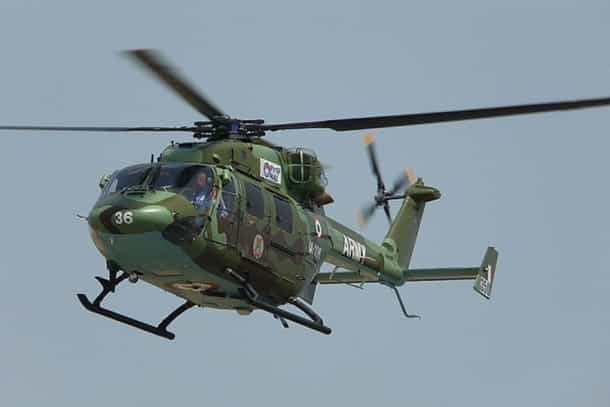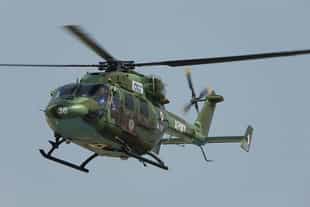Defence
Dhruv Helicopters Grounded: After A String Of Accidents, Safety Regulator Says Critical Design Review Needed
Ujjwal Shrotryia
May 10, 2023, 12:58 PM | Updated 01:25 PM IST
Save & read from anywhere!
Bookmark stories for easy access on any device or the Swarajya app.


The Centre for Military Airworthiness and Certification (CEMILAC) has asked for a design review of a 'safety-critical system' of the Hindustan Aeronautics Limited (HAL) built Advanced Light Helicopter (ALH) Dhruv helicopter following three crashes under two months.
A week ago (4 May), one Indian Army's ALH Dhruv crashed on the banks of Marua river in Kishtwar region of Jammu and Kashmir, killing a soldier and injuring the pilots. This was the third crash of the helicopter under two months.
Incidentally, just a week ago (1 May) of the crash, the forces have cleared ALH for flight operations.
The entire fleet of more than 300 helicopters were grounded after a Navy helicopter ditched (8 March) in the Arabian sea with sudden loss of power.
This was followed by another crash of a Coast Guard Naval Dhruv at the Cochin International Airport on 26 March. The Coast Guard helicopter was on a test flight after extensive maintenance and ground checks.
"Extensive checks on the entire fleet of helicopters, also in service with the Army and Air Force, were under-taken and no signs of any deep-rooted issue with the aircraft were found," a report had than said after clearing the helicopter for flight operations.
Reportedly both helicopters crashed due to failure of controls. "In one case, the crash happened due to improper fitment of washers and in the second case, two similar control rods were interchanged at the time of maintenance," which resulted in the failure of controls leading to sudden loss of power.
"Following the crashes, the entire fleet was assessed by technical teams and no red flags have been raised after thorough checks. Additional training is being given to crews to ensure such issues do not come up again," the report has then said.
However, just four days after clearing the helicopter for operations, the Army ALH crashed in Kishtwar on 4 May, prompting the Bangalore-based safety regulator CEMILAC to step in and carry out a design review of a 'safety-critical system'.
According to a report by Hindustan Times, CEMILAC which functions under Defence Research and Developement Organisation (DRDO) decided to conduct a design review after the earlier report of the expert committee which explored the various reasons for the failure of the control rods that led to the crashes.
These control rods allow pilots to control the helicopter’s motion, and any failure can severely affect power input to the rotor blades and cause accidents, the HT report says adding that, "the regulatory body has red-flagged the drastic reduction in the fatigue life of the rods, the officials said".
"The design, development and qualification of the steel booster control rods that are tolerant to assembly errors shall be expedited, and the compliance of the new design shall be aimed for implementation in six months to one year," the CEMILAC said in a letter to HAL, Army, Navy, Air Force and the coast guard.
The reduction in a fatigue life of the rods happened due to an assembly error of serrated washers in the booster control rods.
“The drastic reduction in the fatigue life of the control rod with wrongly assembled serrated washers has been verified experimentally at Rotary Wing Research and Design Centre (RWR&DC), HAL as part of the committee’s investigation,” the letter said.
“Though the helicopters are matured from the design point of view, having been exploited for more than 3 lakh hours, still there is scope to review the design/lifting aspects of the safety-critical system by an expert committee as a long-term measure,” said the letter, written by CEMILAC director (helicopters and missiles) DM Isack.
Apart from the ALH Dhruv, the forces have also grounded the Light Combat Helicopter (LCH) in service with the Army and the Air Force, which also uses parts from the ALH.
According to the HT report, CEMILAC has provided measures for bringing both the helicopters back to operations, which will include limited clearance for each helicopter for 100 flight hours, and urther clearance up to 500 flight hours or one year, whichever comes first, based on the successful completion of two critical tests conducted by HAL.
These tests involve flight testing of two helicopters with instrumented control rod assemblyfor verifying the multi-axis loads on the control rods, and the fatigue testing of the rods with correctly assembled serrated washers to confirm their original capability, the report says quoting an official.
An accelarated life testing (ALT) methdology is also recommended by the CEMILAC to identify any other failure modes and also assess the life of ALS's integrated dynamic system, which consititutes the main gearbox, upper controls and rotor head.
While the grounding may cause some inconvenience, the safety of the pilots and passengers is of utmost importance, and the efforts being made by CEMILAC and HAL are a positive step towards ensuring their well-being.
Staff Writer at Swarajya. Writes on Indian Military and Defence.





